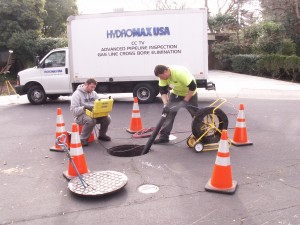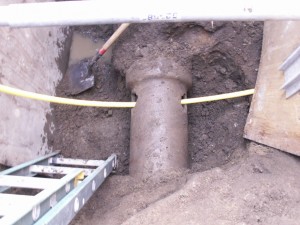April 2012, Vol. 67 No. 4
Features
Palo Alto Institutes Pro-Active Plan To Locate, Correct Crossbores

As crossbores continue to cause concern and controversy across the United States, the city of Palo Alto, CA, is taking a pro-active approach to find gas lines that have penetrated sewer laterals during installation by horizontal directional drilling (HDD), and to correct the problem before a costly and dangerous accident can occur.
In July 2011, Palo Alto initiated a program to make closed-circuit television inspections of every sewer lateral in the city where HDD gas installations have been made near a lateral. A separate program ensures that a new crossbore is immediately discovered — the city requires inspection of a lateral after a gas line has been installed by directional drilling in proximity of the lateral to confirm no crossbore has occurred or to correct it if one is discovered.
Inspections of laterals serving schools, hospitals and other public buildings actually began last spring before the crossbore program was approved, said Greg Scoby, engineering manager, Palo Alto Water, Gas, and Wastewater Utilities Department. Inspection of residential laterals followed. Contractor HydroMax USA is making the inspections.
By the first week of March 2012, approximately 4,000 laterals had been inspected, said Scoby.
“Four gas crossbores have been found to date and repaired upon discovery,” Scoby said. “Seven additional non-gas crossbores were also found. All were telecommunications conduit.”
At the present rate of inspections, Scoby estimated all laterals with potential of containing gas crossbores will be inspected and any crossbores found corrected by December 2012.
City-owned utilities
Palo Alto’s program to eliminate crossbores is simplified by the fact the city is one of the few municipalities in the country that owns and operates basic utility services, including water, wastewater, electric and natural gas distribution, and dark fiber optic cable infrastructure. With sewer laterals and gas distribution operated by the same entity, communication between water and gas personnel is improved, simplifying the task for finding and correcting crossbores.
Many cities have been sharply criticized for avoiding responsibility for crossbores by taking the position that sewer laterals are the responsibility of property owners. Palo Alto has a different perspective.

“Palo Alto always has owned the lower lateral portion of sewer lines connecting individual customers,” said Scoby. “This is not always the case with other wastewater collection systems. We define wastewater laterals as consisting of an upper portion from the property line clean-out to the privately-owned structure, and a lower city-owned portion from the property line clean-out to the main.”
Historically, Scoby continued, the city maintained the lower portion of the lateral due to ownership. Palo Alto previously conducted several assessments of the wastewater collection system, but included only the mains.

“With the adoption of the crossbore safety program,” he said, “we are now assessing the laterals in addition to the mains with an industry standard coding system. Upon completion of the crossbore safety program, we will be able to target lateral maintenance and replacement efforts based on conditional assessment created during the program. Costs of maintenance and replacement efforts will be paid by the city.”
Lack of funds often is cited by cities for failing to address the problem of lateral crossbores.
“Our inspection program is funded from the natural gas utility system,” said Scoby. “Fortunately, with commodity prices falling for natural gas, it was an opportune time to conduct the program with minimal rate impact.”
Scoby said the public has embraced the inspection program.
“From the beginning,” he explained, “our staff realized that we needed to engage our community in this effort prior to the start of the program and a public awareness effort was conducted. This awareness campaign included a press conference, inserts in bills to our customers, mailings to local drain cleaners, plumbers and equipment rental agencies and updating our website to reflect this important safety program. Our customers are very supportive and with the increased awareness of natural gas safety issues, the program has been conducted to date with very little resistance from the community.”
Comprehensive web
A quick look at the city’s website provides information about the crossbore inspection program that clearly explains what crossbores are, how they can occur, has details of the inspection program and answers the most commonly-asked questions.
Palo Alto’s approach to crossbores has generated interest in California and nationwide.
“City representatives are appearing before industry groups with presentations about crossbore inspections,” said Scoby. “Most recently, I was invited to speak at the Northern California Pipeline Users Group (PUG) in Berkley. This is a group of consulting engineers, wastewater and water system operators that conduct an annual seminar. The topic was outside of the normal issues addressed at this seminar and hopefully this presentation increased awareness of the issue with collection system operators. I have also given a crossbore presentation to the Santa Clara Valley section of the California Water Environment Agency consisting of water quality control treatment staff. Most recently, I participated in a crossbore panel discussion at the Common Ground Alliance conference in early March in Las Vegas, NV.”
Certainly, other U.S. cities are aware of Palo Alto’s crossbore inspection program.

“I have spoken to other cities,” said Scoby, “but the topic is usually related to permits or conditions of approval for gas operators to access city owned wastewater collection systems. In my experience, gas operators are driving this investigative effort and need the cooperation of cities, wastewater collection agencies or other entities to create a productive cost efficient program.”
Does Scoby have advice for other cities as they face crossbore issues?
“I would start by meeting with the local gas operator and gauging their program to address this issue,” Scoby said. “This effort can easily be turned into a win-win situation by cooperating with the local gas operator. All of the crossbores we have found to date were associated with trenchless construction methods utilized to install gas systems. If the local gas operator has not used these construction methods, crossbore risk could be minimal. By win-win I am referring to avoided SSO (sanitary sewer overflow) events that were mitigated before video inspection could be conducted. It might be possible for the local agency to work with the gas operator to conduct system assessments and achieve accomplishments related to consent decrees from the local/state wastewater enforcement agency.”
Scoby concludes by adding that all gas operators nationwide were required to prepare and implement Distribution Integrity Management Programs (DIMP) by August 2011 to comply with recently-adopted Department of Transportation regulations requiring gas operators to categorize and evaluate risks associated with their systems.
“I believe the recent adoption of DIMP will increase crossbore investigations for gas operators who have employed trenchless construction methods in the past,” Scoby said. “Hopefully, wastewater collection system operators will partner with their local gas company and work to facilitate these inspections to the benefit of all involved parties.”
FOR MORE INFORMATION:
HydroMax USA, (877) 389-2227, www.hydromaxusa.com
City of Palo Alto Utilities Department, www.cityofpaloalto.org/depts/utl
Cross Bore Safety Association
The Cross Bore Safety Association (CBSA) is dedicated to educating the industry and organizations and agencies with a stake in eliminating crossbore accidents and its
efforts are gaining momentum.
“I became a member of the CBSA in 2009 and have used the available materials
to convince management of the need to conduct Palo Alto’s crossbore program and to guide development and implementation of the program,” said Greg Scoby, engineering manager, Palo Alto Water Gas, Wastewater Utilities Department.
“I cite documents and statistics from the CBSA website in presentations, and I would encourage anyone looking for further information about crossbores to visit this site, www.crossboresafety.org/.”




Comments